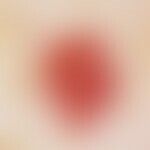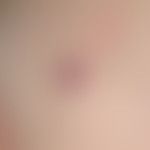Synonym(s)
DefinitionThis section has been translated automatically.
Harmless, frequent, localized or multiple capillary neoplasm, which occurs mainly in the elderly and in multiple cases.
In rare cases, an eruptive occurrence of "senile" angiomas may be an expression of a systemic disease (e.g., a lymphoproliferative systemic disease).
Senile angiomas may be associated with POEMS syndrome or Castleman lymphoma.
EtiopathogenesisThis section has been translated automatically.
The etiopathogenesis of senile (tardive) angiomas is unknown. Thus, the angiogenic factors leading to the cutaneous vascular proliferations are also unknown.
Serum lipids: Normally, angiogenic factors are synthesized in the human body to compensate for the occlusive effects of atherogenic substances such as serum lipids. In a larger study (n=244 subjects), mean levels of total cholesterol, triglycerides, as well as lipoproteins were shown to be higher in subjects with senile angiomas than in controls, with significant differences in total cholesterol and low-density lipoproteins and triglycerides (P < 0.05) (Darjani A et al 2018).
Drugs: In a bivariate analysis of patients with benign prostatic hyperplasia, an association between the eruptive occurrence of cherry angiomas and the application of tamsulosin was demonstrated. Thus, tamsulosin may be as a possible risk factor for the development of cherry angiomas.
Clopidogrel, on the other hand, seems to play a protective role (Nazer RI et al. 2020).
Melanoma and cherry angiomas: Versch. Investigators found a significant association between the incidence of melanoma and eruptive cherry angiomas in younger patients (≤50 years). This association was no longer detectable in older patients (Corazza M et al. 2019).
You might also be interested in
ManifestationThis section has been translated automatically.
Senile angioma is the most common form of acquired cutaneous vascular proliferation. It increases with age (predominantly from the 4th decade of life) due to various angiogenic factors. The exact pathogenesis is unknown. A certain predilection is detectable in the seborrheic skin type. Increased occurrence during pregnancy and in prolactin-producing tumors.
LocalizationThis section has been translated automatically.
Mainly on the trunk, less frequently on the extremities.
Clinical featuresThis section has been translated automatically.
Completely asymptomatic, 0.1-0, cm in size, sharply circumscribed, initially bright red, later dark red to purple, soft, flat papule with a smooth, shiny surface. Initially, there is a punctate, intensely red spot that can be pushed away with the finger if more compression is applied, which gradually (within months) widens and grows out in a cushion-like exophytic pattern. Senile angiomas can occur singly, but also very numerous, disseminated.
In case of thrombosis (e.g. after banal traumatization) the senile angiomas may appear as solid, black papules (DD: melanoma, malignant, nodular). Risks of bleeding are negligible.
HistologyThis section has been translated automatically.
Differential diagnosisThis section has been translated automatically.
TherapyThis section has been translated automatically.
A medical indication for removal is only given in case of constant mechanical irritation at unfavorable localizations.
If desired: electrocautery or laser treatment(argon laser, dye laser).
Alternative: Therapeutically, sclerotherapy with sodium tetradecyl sulfate 3% proves to be effective. It offers an economical alternative to other available conventional methods (Jairath V et al. 2014).
LiteratureThis section has been translated automatically.
- Aghassi D (2000) Time-sequence histologic imaging of laser-treated cherry angiomas with in vivo confocal microscopy. J Am Acad Dermatol 43: 37-41.
- Corazza M et al (2019) Eruptive cherry angiomas and skin melanoma: a fortuitous association? Melanoma Res 29:313-317.
- Darjani A et al (2018) Evaluation of lipid profile in patients with cherry angioma: A case-control study in Guilan, Iran. Dermatol Res Pract 2018:4639248.
- Jairath V et al (2014) Is sclerotherapy useful for cherry angiomas? Dermatol Surg 40:1022-1027.
- Nazer RI et al (2020) Cherry angioma: A case-control study. J Family Community Med 27:109-113.
Incoming links (13)
De morgan spot; Haemangioma senile; Haemangioma, seniles; Hemangioma, capillary; Hemangioma, cavernous; Hemangioma senile; Hemangioma, senile; Hemangioma, tardives; Hereditary haemorrhagic telangiectasia ; Liver hemangioma; ... Show allOutgoing links (14)
Angiokeratome, solitary; Angioma serpiginosum; Argon laser; Castleman lymphoma; Clopidogrel; Dye laser; Fabry's disease; Hereditary haemorrhagic telangiectasia ; Laser; Melanoma cutaneous; ... Show allDisclaimer
Please ask your physician for a reliable diagnosis. This website is only meant as a reference.





















